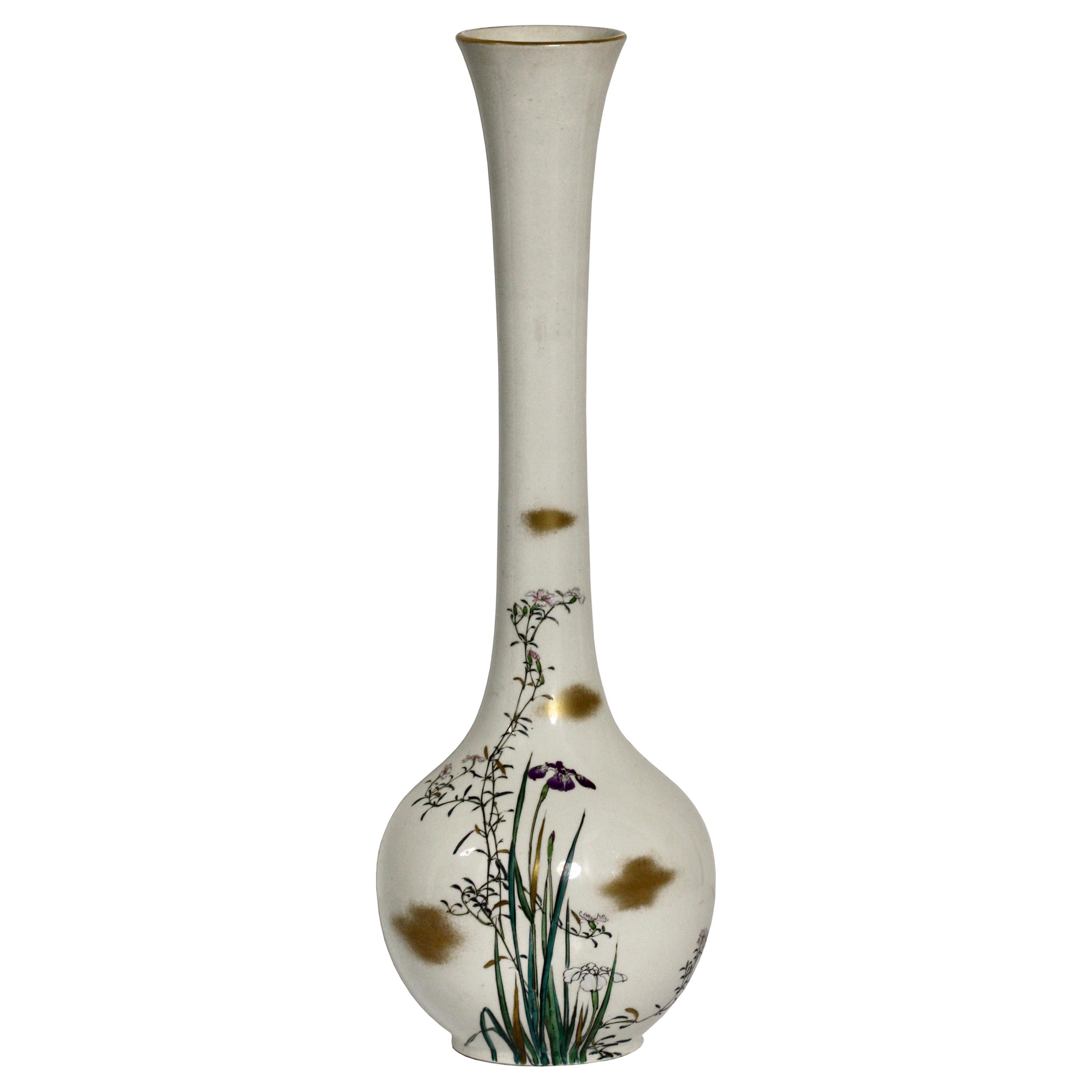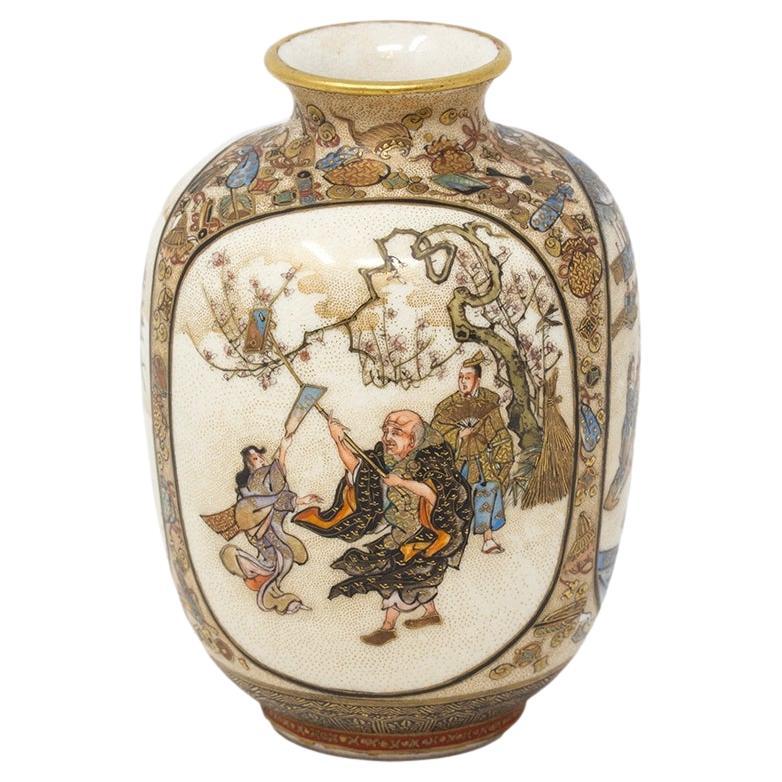Items Similar to Large Antique Meiji period Japanese Satsuma Pied de Stal Vase holder
Want more images or videos?
Request additional images or videos from the seller
1 of 12
Large Antique Meiji period Japanese Satsuma Pied de Stal Vase holder
About the Item
Lovely and rare piece.
A superb blue and white porcelain Dish bowl, with a leaf pattern. Made by Fuji Shumei
Fujii Mr. Aki Fujii's specialty is the technique of drawing a mountain by simulating the veins of a leaf, called the “leaf technique”, as if it were a complex tree branch.
When young leaves such as magnolia are pressed against unglazed pottery like Japanese paper dyeing and bleeding Kuresu, the veins of the leaves emerge as dark lines, and the mountains are drawn by arranging them.
This technique is used to capture the characteristics of the season, and the Arita landscape itself, which I imagined in my mind, is depicted in the work.
Mr. Akiaki Fujii has won many prizes including the Japan Ceramic Art Exhibition and the Kyushu Yamaguchi Ceramics Exhibition Minister of Education Award.
Period
20th century
A pot with dyeing the towering mountains was painted in front of me. If you look closely with your face close, you can see that even the branches of the tree are growing densely. The distant mountains are pale and small. On the other hand, the nearby mountains are drawn thick and large, and I realize that each tree is in the shape of a leaf. Dr. Aki Fujii is synonymous with this "tree leaf technique," which draws a mountain with veins resembling complex tree branches.
When young leaves such as magnolia are pressed against unglazed pottery like Japanese paper dyeing to let gosu bleed, the veins emerge as dark lines, and mountains are formed by lining them up. Mr. Fujii explains, "The mountain is the best way to make the best use of the shape of the leaves. What I draw is the Arita landscape itself that I imagined in my mind." The origin of this style was the leaf of a single tree, which was found only during the walk.
Mr. Fujii, who is also familiar with the bones, said, "In the Meiji era, roasted plates made of wax were made, but these are so-called handmade products. Spare no effort It is said that it takes one to two days to draw a mountain on one vessel.
The Fujii family is a family lineage that has been involved in pottery for generations, such as being allowed to use the family name sword as a pottery kiln during the Edo period. Mr. Fujii's pottery career begins with a 15-year-old painting apprentice. In his twenties, while working for a local ceramics manufacturer, he challenged to exhibit at Nikko. He became independent as a painting craftsman the year after he won the first prize, and opened the kiln 10 years later.
During this time, he has been working on various techniques, including the "cotton thread technique," which involves spraying soil that has been melted with water onto unglazed wrapping yarn to remove the thread and create a three-dimensional effect. At the time of the Boom in Komari, there were times when products that could sell were made more and more, which strengthened the IDEA that “business and art are different things”. I still have the anxiety that "good-looking products sell well, and really good works don't sell well. That's a pain."
After receiving the Prefecture Art and Cultural Achievement Award six years ago, Mr. Fujii has refrained from exhibiting activities such as exhibitions and solo exhibitions at pottery exhibitions for health reasons. On behalf of them, the eldest son, Tsuyoshi (31), is developing an active creative activity using blue-white porcelain. He looks to his successor, who pursues his way with a style different from his father's.
Mr. Fujii himself said, "I think I can make another expression with Konoha technique. I want to open a hole in Arita who is somehow stuck", and he is eager to go outside again.
Condition
Perfect. 450x72mm Diameter x Height
Period
20th century Showa Periode (1926-1989).
- Dimensions:Height: 16.93 in (43 cm)Diameter: 7.09 in (18 cm)
- Style:Qing (Of the Period)
- Materials and Techniques:
- Place of Origin:
- Period:
- Date of Manufacture:20th Century
- Condition:Wear consistent with age and use. Minor losses.
- Seller Location:Amsterdam, NL
- Reference Number:1stDibs: LU4863233746982
About the Seller
5.0
Gold Seller
These expertly vetted sellers are highly rated and consistently exceed customer expectations.
Established in 2015
1stDibs seller since 2019
158 sales on 1stDibs
Typical response time: 9 hours
- ShippingRetrieving quote...Ships From: Amsterdam, Netherlands
- Return PolicyA return for this item may be initiated within 14 days of delivery.
More From This SellerView All
- Large Antique Meiji Period Japanese Satsuma Vases Unmarked But with ReceiptLocated in Amsterdam, Noord HollandPair of Satsuma vases of large size with an interesting receipt from a Russian store in 1969. Condition Vase 1 perfect, only a firing flaw in base, Vase 2 3 chips to upper rim ...Category
Antique 19th Century Japanese Qing Ceramics
MaterialsPorcelain
- Large Antique 19-20th C Japanese Satsuma Vase Japan Meiji Period LandscapeLocated in Amsterdam, Noord HollandFabulous Satsuma vase with a circular mountainious landscape scene with a bridge and ladies in a pagode garden. Condition Overall condition some spots of enamel loss on the body,...Category
Antique 19th Century Japanese Meiji Ceramics
MaterialsEarthenware
- Antique 19th Century Japanese Satsuma Vase Japan Arhat Figures Meiji PeriodLocated in Amsterdam, Noord HollandFabulous Japanese Satsuma vase. Marked Base: ??? Dai-Nippon ?? Satsuma ?? Kikkoen 2 Condition Overall condition perfect. Size 90 x 55mm Period Meiji Periode (1867-1912).Category
Antique 19th Century Japanese Meiji Ceramics
MaterialsEarthenware
- Antique 19th Century Japanese Satsuma Baluster Vase Japan Boys Meiji PeriodLocated in Amsterdam, Noord HollandFabulous Japanese Satsuma Baluster vase, small sized. Unmarked Condition Overall condition 1 frit to rim, further crackled as usual. Size: 125mm Period Meiji Periode (1867-19...Category
Antique 19th Century Japanese Meiji Ceramics
MaterialsEarthenware
- Pair Antique 19c Japanese Kyo Satsuma Seizan Vase Japan Procession Meiji PeriodLocated in Amsterdam, Noord HollandDescription A pair of Japanese Satsuma 'processional' vases, Meiji period Of ovoid form with everted rims, each painted with a procession of figures in traditional robes...Category
Antique 19th Century Japanese Meiji Ceramics
MaterialsPorcelain
- Antique 19th Century Japanese Satsuma Vase Japan Arhat Figures Meiji PeriodLocated in Amsterdam, Noord HollandFabulous Japanese Satsuma vase. Marked base: ???? Dai Nippon Koku ??? Satsuma Yaki ??? Kitayama Ga (draw) Condition Overall condition perfect. Measu...Category
Antique 19th Century Japanese Meiji Ceramics
MaterialsEarthenware
You May Also Like
- Japanese Satsuma Earthenware Vase, Meiji PeriodLocated in West Palm Beach, FLJapanese Satsuma Earthenware Vase, Meiji Period, 1868-1912, of baluster form, the decorated in poly-chrome enamels and gilt on a clear crackle glaze with a Daimyo procession, the nec...Category
20th Century Ceramics
MaterialsCeramic
- Kinkozan, Japanese Satsuma Vase, Meiji PeriodBy KinkozanLocated in West Palm Beach, FLKinkozan, Japanese Satsuma vase, Meiji Period (1868-1912) Of baluster form with an elongated neck decorated in polychrome enamels and gilt on a clear crackle glaze in an Art-Nouvea...Category
20th Century Ceramics
MaterialsCeramic
- Pair of Meiji Period Japanese Satsuma VasesLocated in New York, NYPair of very fine quality early Meiji period Japanese Satsuma vases.Category
Antique Late 19th Century Ceramics
MaterialsCeramic
- Japanese Hand Painted Meiji Period Satsuma VaseBy KinkozanLocated in Newark, EnglandSquat Bulbous Form From our Japanese collection, we are delighted to offer this Japanese Meiji Period Satsuma Vase. The Satsuma vase of squat bulbous form with a tightly pinched nec...Category
Antique Late 19th Century Japanese Meiji Ceramics
MaterialsCeramic, Earthenware, Pottery
- Japanese Meiji Period Satsuma Vase by KinkozanBy KinkozanLocated in Newark, EnglandThe vase is potted in globular form with a tightly pinched neck and rolled top rim beautifully decorated with four highly detailed individual panelled scenes. The first a Geisha bari...Category
Antique Late 19th Century Japanese Meiji Ceramics
MaterialsCeramic, Earthenware, Pottery
- A Magnificent Japanese Satsuma Vase. Signed. Meiji period.Located in London, GBA Magnificent Japanese Satsuma Vase. Signed. Meiji period. 19th C A Fine Japanese satsuma vase of a baluster form finely painted in Satsuma enamels enhanced with gold paint,decora...Category
Antique Late 19th Century Japanese Ceramics
MaterialsCeramic
Recently Viewed
View AllMore Ways To Browse
Period Japanese
Japanese Paper
Best Asian Art
Antique Meiji
Japanese Large Antiques
Vintage Japanese Patterns
Vintage Japanese Pattern
Vintage Veins
Used Ceramics Kilns
Japanese Mountain Furniture
Asian Go
Craftsman Period
Pale Ceramics
Large Asian Water
Local Asian Furniture
Pottery Kiln Used
Small Japanese Ceramics
Selling Ceramics





